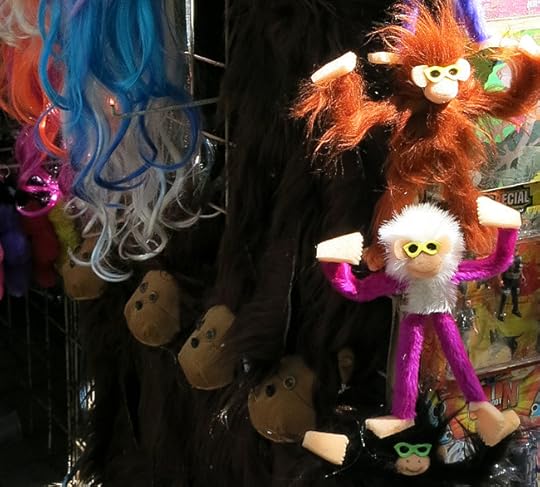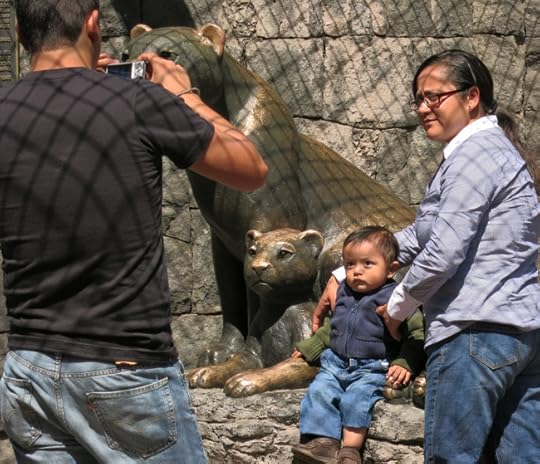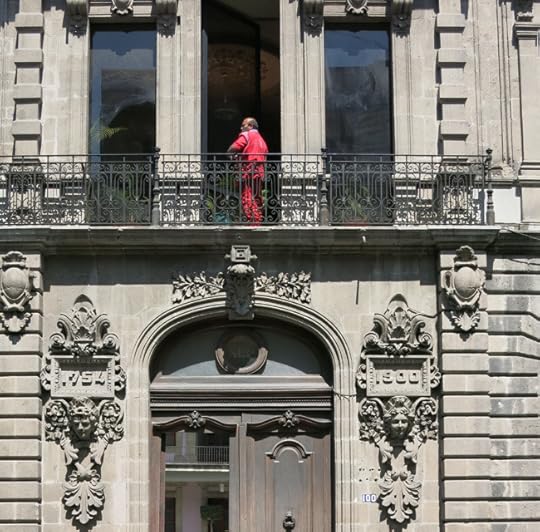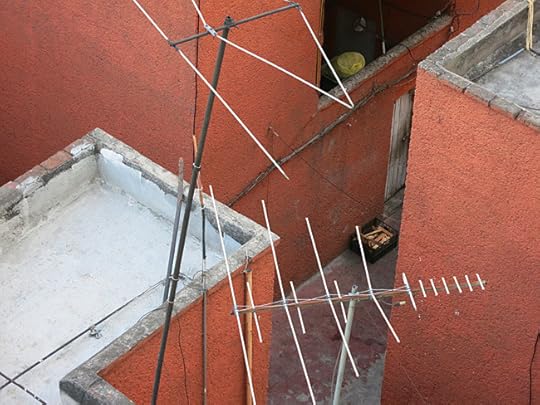Elizabeth Adams's Blog, page 82
March 13, 2013
Linguistic Detour
March 10, 2013
People .1

Diners at their 3:00 pm main meal, which can go on until 5 or later.
Schoolgirls.
Two women with roses.
A young professional, after work.
Hip kid at the Zócalo, Metropolitan Cathedral in the background.
March 7, 2013
An Afternoon with Diego Rivera

After a morning at the Metropolitan Cathedral, which forms the northern side of Mexico City's huge central square, the Zócalo, I went to the Palacio Nationale, along the square's eastern side. This is the official presidential complex, and much of it is open to the public. It's been the seat of ruling power in Mexico City since the Aztec times; the palace was begun around 1520 by the Spanish conquistador Hernán Cortés after his conquest of the city, on the exact site where Moctezuma II lived and ruled, and incorporates much of the Aztec building material in its construction.
Here I am on the second level, having climbed the main staircase. Below is the view down into the central courtyard, where the first recorded bullfights in New Spain took place.
The proportions and elegance of the building alone would be reason enough to visit. But I was like many who come here to see something else: the huge murals by Diego Rivera which decorate the main stairwell and northeastern half of the second colonnade level. When I walked in, I really couldn't believe my eyes. The murals are much larger and more extensive than I expected, and how astounding is the story they tell.
The first set of murals are arranged in a tryptich in the main stairwell. Above, you are looking to the south.
This is the largest panel, at the top of the stairwell on the western wall. (I apologize, but there was a tremendous glare from the bright sun.) This panel tells the story of the Spanish conquest, the role of the church, the treatment of the Indians, and the Inquisition.
A detail of the upper right portion of the western wall. I think some of the best painting and composition is in this section, though every single painting was extremely impressive.
The northern panel shows the Aztec civilization before the coming of Cortes and the Spanish. A detail of the lower far right is below, showing the powerful monumentality of Rivera's figures.
Opposite, on the southern wall the mural depicts 20th century political history, the struggle of the workers, and the Revolution. The figure at the top is Karl Marx, and you can see Rivera's wife, Frida Kahlo, behind the woman in red in the bottom center.
The amount and quality of painting inthe stairwell is pretty staggering, but as you leaving it and move around the colonnade to the north, you find another series of large murals that tell the story of Mexico City, beginning with the Aztec city of Tenochtitlan, built on an island in Lake Texcoco in 1325, and almost completely destroyed by the Spanish in 1521.
You can see the volcanoes that still ring the city in the distance. Rivera has been accused of glorifying the Indians; here he does acknowledge their practice of human sacrifice by showing blood on the pyramid steps. Along with everything else, the main pyramid of the Aztec city was razed and the Spanish cathedral built on the same spot, just a few steps from where I was standing. It was only in the last quarter of the 20th century when its ruins were discovered; now the Templo Mayor can be visited as an archaeological site, just to the north of this building.
The hallway murals continue, showing aspects of Aztec culture like the distillation of mescal, the collection of rubber, and the making of bark cloth.
You can see Rivera's signature in the very top center of the image above.
For the study of masterful mural-painting, I can't imagine a more brilliant place than this. Each of these hallway paintings tells a story through powerful forms, masterful composition, and perspective that leads the eye into the middle distance and into the deep space of the background. I was in awe, not only of Diego Rivera's skill, but his vision -- and for the sheer volume of his achievement on these walls, which represents only a fraction of his life's work.
It was also very moving to me to see public art like this in a presidential palace, telling a story that anyone can understand, as unvarnished as any literature. (Just imagine, for a moment, what stories a parallel work would have to include in the U.S. capitol, or the White House, and how that might change America's national narrative.)
One of the aspects of Mexico City that impressed me the most was how present its entire history was, everywhere we went, and no matter who we talked to. It is something that unites the people, and of which they all seem to be proud. While I was viewing these murals, a large school group also came, with a teacher who talked to them in front of each painting. This public art -- and these are only a small portion of the murals which decorate this city -- must play an important role in the consciousness of the people, and must also affect their whole idea not only of what art is and can be, but of who they are.
I think this is something Rivera intended to show them. After spending hours looking at the people in these murals, I walked out into the crowded streets -- and there they were.
March 5, 2013
Adios
Everyone warned us about the altitude, the pollution, the potential for theft or worse, illness, squalor, traffic. All have been, in our experience, exaggerations. It's a huge city with a lot of poverty and problems, and yes, you have to be careful. But I have not felt afraid, and I think I have pretty good antennae now for those sorts of urban threats. Except for a little awareness of the altitude the first day, breathing hasn't been a problem at all; in fact the air has been clear enough that we've been able to see the stars every night from our hotel window. I know it's not always that way, but while we've been here the air quality has been fine. There are sweepers and cleaners everywhere; when you consider what it actually copes with, Mexico City seems cleaner in many ways than Montreal. The traffic is tremendous, but somehow it works, people manage to cross streets, the subway is efficient, the buses run.
We leave tomorrow night, late, and it will be reluctantly - both because I'm dreading going back to what sounds like horrible weather in Montreal, but more so because each day this astonishingly vibrant and beautiful city, with the oldest history in all the Americas and -- most of all -- some of the warmest people I've ever encounted when traveling, have lodged deeper in my heart. I am way behind in writing and about what's happened, and will continue after we get home, and I've made no drawings at all -- but that's because I wanted to see and experience as much as I could rather than sitting in one place.
There's a lot to think about, too.
This trip couldn't have been more different from our visit to Iceland last year, but the seismic activity both places share seems to have shaken me once again; I'm coming back changed, with wider eyes, and a broader abyss in my soul, cleft by the people I've encountered.
If one picture I've taken encapsulates how I've felt, perhaps it's the one at the top of this page. I know I will carry the beautiful faces of the Mexican children with me until I come back; they've touched me again and again.
March 4, 2013
At the Zoo: 2

Outside the entrance to the zoo (and, for that matter, outside the entrance to almost every place a crowd passes through) individual vendors set up stalls and compete with color, noise, calls, and whatever attractions they can think of to sell their goods or services.
The gauntlet at the zoo was very long and particularly creative, offering a everything from the typical, ubiquitous snacks to all sorts of zoo-related paraphanalia, photos with Spiderman and Captain Marvel, fuzzy monkeys that you could wrap around your shoulders or perch on your head, and some of the best face-painting I've ever seen.
We succumbed after half an hour of walking through this; J. bought some old-fashioned cottn candy, spun on the spot in a machine like the ones I remember from county fairs when I was a kid, and I bought a cone of real potato chips. We had had some the day before; the vendor makes them fresh, puts them still warm in a paper cone, squirts on a little chili sauce, and then squeezes a lime over them. Need I say more?
We never figured out what these were -- at first I thought they were fruit leathers, but they're some sort of candy.
Then, amid all the noise and shouting, we came upon a small stall filled
with bonsai. In a quiet voice, a Japanese man was explaining to these
young people what the plants were and how he cultivated them. It was
like a contemplative oasis in the middle of...well... a zoo.
In such a teeming city as this -- a mind-boggling 20 million people in the greater metropolitan area -- the first impression, especially when encountering the traffic or the streets, is of barely-contained chaos. But again and again this week, I've seen scenes like this: little pockets of calmness, quiet, and beauty in which people are alone or with a friend or two. And even in the most crowded places, Mexicans don't seem agitated or numb. They are alert, warm, friendly, helpful, and coping with an urban situation that seems, on the surface, utterly impossible.
At the Zoo: 1

Along with what seemed like half of Mexico City, we went to the zoo today. We watched a few animals, including homo sapiens.
The big cats were particularly impressive. I had just finished reading Life of Pi, so the size and majesty of the bengal tiger (not shown here; his body was mostly behind a rock) felt especially immediate today. The panther seemed agitated and paced back and forth on top of his rock ledge, ominous and menacing.
I had never seen a jaguar before. Hold him in your mind, for he's important to Mexico, and coming back soon in a different guise.
March 3, 2013
Looking In
Balconies and Colonnades

I am showing you beautiful things because as yet it's difficult to write about the human ones. This is one of the world's "Maximum Cities," as I am learning with greater intensity each day we are here. An absolutely remarkable place; one wonders how it can possibly survive, but it does, and has.
March 1, 2013
Warmth and Chaos
Mexico City, 8:30 am. There's brilliant sun reflecting off a large white wall down the block,
and it's shining into our room this morning. The loudspeaker "good
mornings" have already been completed, and the kids have gone inside for
the beginning of their school day. We've eaten a tangerine and are
getting going slowly, taking advantage of the internet access that seems
much more reliable in the morning than at night.
I don't know what I had expected, actually, but Mexico City is already shattering any preconceptions I had. There are so many layers -- the obvious historical ones, the social and economic ones, the very old, beautiful, often crumbling buildings teeming with new uses: fabric stores, paper stores, toy stores, shoe stores, gold, cameras, books.
Rising above all of this is the "new"
Mexico -- shiny, proud, and affluent -- symbolized by some astounding
architecture and modern design, which builds on motifs and styles that
go all the way back to the land and the visual language of its first
inhabitants. The traffic is relentless and chaotic; the city almost
incomprehensibly vast; people crowded, extremely warm, somehow managing
to keep things going in a place where there are few rules and
difficulty applying those that do exist. Cairo comes to mind -- another dry hot city
teeming with people and marked by pyramids -- and I wonder about
parallels, but I haven't been there in person.
And in contrast to the teeming streets, there are pockets everywhere of calmness, oases of green in the shade of trees, small gardens and courtyards where people sit quietly, talking, or just resting from the sun, from life.
We're going back to the Centro Historico today, to look at churches
and murals, and the ruins of the Aztec city that Cortés destroyed. In
the center of Zocalo this week is a military exhibition - tents and tanks and
planes and Mexican soldiers - and there are demonstrators shouting
outside the presidential palace, police vans parked on the side streets
and phalanxes of riot police near the palace, wearing helmets and
carrying thick plastic shields; even more ominous are the police trucks
with mounted machine guns and black-garbed troops that drive through the
streets as a show of force and authority.
Meanwhile the hurdy-gurdy
players simply turn their cranks, the tortilla-makers slap wet tortillas
on their street-ovens, children munch fried cactus leaves, the blind
man in his fuschia shirt miraculously taps his way through the traffic,
vendors hawk their small assortments of colored hair elastics, hats,
bandanas, cards and cigarettes, and men and women step off the street into a
shrine smelling of hot paraffin, where they kneel and cross themselves in front of a shiny black
Christ hanging on a cross.
February 28, 2013
7 am, Mexico City

Grateful for a good night's sleep. Yesterday began at 4:30 am, and ended at 11:30 pm. The flight was uneventful until the end, when we came in over the volcano- and mountain-ringed city and encountered a lot of turbulence. I'm susceptible to motion sickness, though I'm usually OK on planes, but the taxi ride from the airport to the hotel in heavy rush hour traffic finished me off, and I wasn't good for much last evening. Today I feel a lot better, and we're about to eat some breakfast and head into the historical district.
Our hotel is in a real neighborhood, and the sounds of daily life drift up into our window, like the birds that sing constantly and flutter by. Last night we heard a muezzin - not something I'd expected - and this morning at eight, a loudspeaker or megaphone from a nearby school, welcoming the children with a loud and cheerful buenos dias! which they all answered, many times over. I could see them, lining up in a courtyard with green walls in back of the school, and the noisy, happy exchange between the teacher or principal and the kids went on for at least fifteen minutes before they went inside. Beyond the school there are palm trees, and then the tall buildings begin. There's more bright color, just from this window, than I can recall in all of Montreal, except for the Portuguese neighborhood not far from our home.
Everyone speaks about the air quality here as being abysmal, but right now it's not too bad. I can see some pinkish smog over the city, but the sky is blue and last night, from the window, I could see stars.
The altitude, however, is something I can definitely feel. I have a slight headache, and we both feel more fatigued than usual. We'll see how it is when we're out walking about. Hasta pronto!

















































